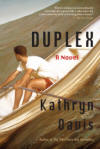Duplex
Kathryn Davis begins her novel Duplex with a tableau of children at play at summer’s end on a safe suburban street at dusk. Perhaps this is the early 1960s: no internet, television watched on a “console.” To immediately insert into this landscape robot neighbors and a Mephistophelean sorcerer complicates suspension of disbelief. Questions arise: if this place is not what it seems, what is it? What are the rules here? Who’s making the rules?
Kathryn Davis begins her novel Duplex with a tableau of children at play at summer’s end on a safe suburban street at dusk. Perhaps this is the early 1960s: no internet, television watched on a “console.” To immediately insert into this landscape robot neighbors and a Mephistophelean sorcerer complicates suspension of disbelief. Questions arise: if this place is not what it seems, what is it? What are the rules here? Who’s making the rules?
An unidentified narrator weaves two threads. One is the story of Mary and Eddie, childhood sweethearts, who live in a suburban complex of duplex homes, as does their teacher, Marjorie Vicks. They each are ensorcelled in different ways by Walter Ward, immediately identified as the sorcerer. He drives through the neighborhood in a silver-grey sedan. We learn that he’s put Miss Vicks under a sexual trance. Eddie briefly disappears and returns to become a star baseball player, but without a soul. Mary grows up and gives up on her love for Eddie. She marries the sorcerer, who arranges for her an idealized life devoid of creativity and feeling. Overhead fly the mysterious scows (perhaps from other universes) somehow related to the robot family that lives in one of the duplexes. The robots seem to take human form and try to “pass” by carefully studying patterns of human emotion and behavior. The past, present, and future fold around and through each other. In marriage, Mary gives up her art and tries to find satisfaction in sewing clothes and raising a not-quite-human, perhaps robot child who, as a teenager, rejects her. She is left to face the void.
Within this Faust-like parable, Davis seems to have an underlying subversive purpose. Mary’s dilemmas seem right out of The Feminine Mystique. As for the robots—in the suburbs how many of the neighbors might have been robots presenting a facade of conformity? The character of the teacher seems to sum up the basic conundrum: “‘What am I doing here?’ Miss Vicks wondered aloud. ‘Whose life is this?’”
The second thread is told by the same narrator who reveals that she is one of a group of pre-adolescent girls living in the duplexes. They spend their summers trading picture cards and listening to an older girl, Janice, tell stories.
Generally speaking the adults on the block considered [Janice] a liar. She said her mother beat her with a willow branch and she had the stripes on her back to prove it. She said humans had been right when they said the world was flat and round like a coin and you could fall off the edge.
Janice’s stories come between the chapters that follow Mary, Eddie and company. The listeners grow up, Janice gets a boyfriend, marries, divorces. But even as they age, they come back to the stories.
Janice tells them about the “Rain of Beads”: girls are seduced by handsome robots wishing to reproduce in the human way. “What happened next is too horrible to describe. . . . The information the robots based their plan on was poetry, which they are incapable of understanding.” The seduced girls are reduced to a cellular rain.
This story, like others, echoes the parallel narrative thread. In an earlier chapter involving Mary and Eddie, the “Rain of Beads” turns up as the theme for their prom night:
which some teachers had objected to as inappropriate. . . . If it wasn’t possible to reinvent the past in such a way as to make it conform to the present’s cheerful view of the way things ought to have been why bother living? Red light for blood and yellow for plasma and blue for tears . . .
Janice’s invented mythologies and the alternative story of the duplex fold together.
This raises more questions: is Janice, the storyteller, describing a true past for this created world? Is she really the stand-in behind which the narrator hides? Why is this narrator so omniscient? Does the narrative connection between threads call into question her reliability? In other words, is she describing a world for which the reader should suspend disbelief, or should we remain aware that she is just making it all up?
Duplex explores the hinge between real and unreal, past and future, human vs. nonhuman: “everything that is and has been and always will be—became for a moment like a huge thick velvet curtain, and everything that ever considered itself to be separate from anything else no longer was but only just for that moment . . .” Davis does not makes concessions to the rules of speculative and fantasy fiction. She creates her own genre. In haunting prose, the work moves along with a provisional quality: a storyteller improvising; pieces of dream logic that don’t hold up when awake. Finally, the strands begin to gather together into a strange and poignant whole.





